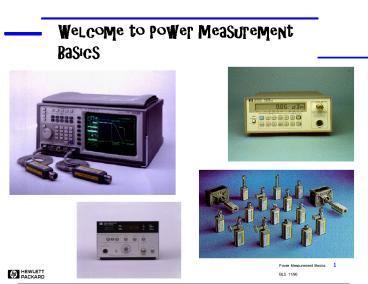Welcome to Power Measurement Basics - PowerPoint PPT Presentation
1 / 40
Title:
Welcome to Power Measurement Basics
Description:
Welcome to Power Measurement Basics We know that when a simple Wheatstone bridge is balanced, meaning both sides of the bridge are the same, there is no voltage ... – PowerPoint PPT presentation
Number of Views:195
Avg rating:3.0/5.0
Title: Welcome to Power Measurement Basics
1
Welcome to Power Measurement Basics
2
Agenda
3
Importance of Proper Power Levels
- Power too low
- Signal buried in noise
- Power too high
- Nonlinear distortion can occur
- Or even worse!
4
Importance of Power in Microwave Applications
5
Units and Definitions
- Unit of power is the watt (W) 1W 1 joule/sec
- The watt is a basic unit 1 volt is defined as 1
W/ampere - Relative power measurements are expressed in dB
P(dB) 10 log(P/Pref) - Absolute power measurements are expressed in dBm
P(dBm) 10 log(P/1 mW)
6
Power P (I)(V)
AC component of power
DC component of power
P
Amplitude
t
I
V
7
Power Measurements at Different Frequencies
- DC
- Low Frequency
- High Frequency
V
-
I
V
I
8
Agenda
9
Types of Power Measurements
- Average Power
- Pulse Power
- Peak Envelope Power
CW RF signal
Pulsed RF signal
Gaussian pulse signal
10
Average Power
Average over several modulation cycles
time
Average over many pulse repetitions
11
Pulse Power
- Complete modulation envelope analysis
Pulse Top Amplitude
90 amplitude points
50 amplitude points
Average Power
Pulse Base Amplitude
10 amplitude points
t
Offtime
Risetime
Falltime
PRI
12
Peak Envelope Power
For pulses that are not rectangular
13
Measurement Types Summary
- For a CW signal, average, pulse, and peak
envelope power give the same results - Average power is more frequently measured because
of easy-to-use measurement equipment and highly
accurate and traceable specifications - Pulse and peak envelope power can often be
calculated from average power
14
Agenda
- Importance and definitions of power measurements
- Types of power measurements
- Measurement uncertainty
- Sensor types and power meters
- Considerations in choosing power measurement
equipment
15
Sources of Power Measurement Uncertainty
- Sensor and source mismatch errors
- Power sensor errors
- Power meter errors
Sensor
Mismatch
Meter
16
Calculation of Mismatch Uncertainty
Power Meter
Signal Source 10 GHz
Power Sensor
HP 8481A
HP 437B
SWR 1.18
SWR 2.0
r 0.33
r 0.083
SOURCE
SENSOR
Mismatch Uncertainty 2 r r
100
SOURCE
SENSOR
Mismatch Uncertainty 2 0.33 0.083 100
5.5
17
Power Sensor Errors (Effective Efficiency)
Various sensor losses
Power Meter
DC signal
P
r
Power Sensor
P
gl
Cal Factor
18
Power Meter Errors
Zero Carryover
/- 1 count
Power reference error
Drift
Noise
Zero Set
Instrumentation error
19
Calculating Power Measurement Uncertainty
Mismatch uncertainty Cal factor
uncertainty Power reference uncertainty Instru
mentation uncertainty Now that the
uncertainties have been determined, how are they
combined?
5.5 1.9 1.2 0.5
20
Worst-Case Uncertainty
- In our example worst case uncertainty would
be 5.5 1.9 1.2 0.5
9.19.1 10 log (1 0.091) 0.38 dB-
9.1 10 log (1 - 0.091) - 0.41 dB
21
RSS Uncertainty
- In our example RSS uncertainty would be
2
2
2
2
(5.5) (1.9) (1.2) (0.5)
6.0 6.0 10 log (1 0.060) 0.25 dB -
6.0 10 log (1 - 0.060) -0.27 dB
22
Agenda
- Importance and definitions of power measurements
- Types of power measurements
- Measurement uncertainty
- Sensor types and power meters
- Considerations in choosing power measurement
equipment
23
Methods of Sensing Power
Power Meter
Substituted DC or low frequency equivalent
Net RF power absorbed by sensor
Power Sensor
24
Thermistors Thermocouples Diode Detectors
Characteristic curves of a typical thermistor
element
25
Thermistors Thermocouples Diode Detectors
- A self-balancing bridge containing a thermistor
Thermistor mount
26
Power Meters for Thermistor Mounts
- HP 432A Power Meter
Thermistor mounts are located in the sensor, not
the meter.
27
Thermistors Thermocouples Diode Detectors
- Physics of a thermocouple
E-field
Bound Ions
Diffused Electrons
28
Thermistors Thermocouples Diode Detectors
- The principles behind the thermocouple
Metal 1
Cold junction
Hot junction
-
Metal 2
V V V - V
1
2
h
0
29
Thermistors Thermocouples Diode Detectors
RF power
gold leads
gold leads
- Thermocouple implementation
cold junction
C
c
Thin-Film Resistor
n - Type Silicon
hot
hot junction
n - Type Silicon
RF Input
Thin-Film Resistor
cold
To dc Voltmeter
Thermocouples
30
Thermistors Thermocouples Diode Detectors
Linear Region
Square Law Region of Diode Sensor
V
µ
(log)
o
Noise Floor
watts
0.1 nW
0.01 mW
-20 dBm
-70 dBm
31
Thermistors Thermocouples Diode Detectors
- How does a diode detector work?
-
32
The Basic Power Meter
Meter
Diode Sensor
Synchronous Detector
Diode Detector
LPF
BPF
ADC
Ranging
Chopper
DC
RF
AC
AUTOZERO
Square Wave Generator
µProcessor
220 Hz
DAC
33
Agenda
- Importance and definitions of power measurements
- Types of power measurements
- Measurement uncertainty
- Sensor types and power meters
- Considerations in choosing power measurement
equipment
34
Considerations in Choosing Power Measurement
Equipment
35
Thermistors as Transfer Standards
Microcalorimeter National Reference Standard
NIST
Working Standards
NIST
Commercial Standards Laboratory
Rising Costs / Better Accuracy
Measurement Reference Standard
Manufacturing Facility
Transfer Standard
General Test Equipment
User
36
Power Ranges of the Various Sensor Types
Thermocouple square-law region
Extended range using an attenuator
Diode detector square-law region
dBm
-70
--60
-50
-40
-30
-20
-10
10
20
30
40
50
0
37
Susceptibility to Overload
38
Frequency Ranges
39
Reflection Coefficient
40
Any Questions?

